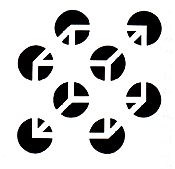|
|
|||||||
 |
|||
 |
|||
|
|
||||||||||||||||||||||||||||||||||||||||||||||||||||||||||||||||||||||||||||||||||||||||||||||||||||||||
| The figures
above represent probably the best known of all ambiguous depth figures,
and many such figures exist.
Fixate on any one of them and with very little effort you should experience a spontaneous depth reversal. In some cases you will perceive a change in orientation and in others the numbers of cubes or prongs will change. Notice that your brain only chooses one interpretation at a time, and not some odd mixture of both interpretations. Your visual system is constrained by how it interprets a two-dimensional image into a three-dimensional mental representation. These two-dimensional figures suggest a three-dimensional object, but these drawings also give contradictory cues for depth perception. The two-dimensional figure is unstable because in the real three-dimensional world, these figures could equally exist in one of two different configurations. When two constraints are in conflict you get an ambiguous figure, which "flip-flops." When depth cues favoring a particular orientation are added to an ambiguous depth figure, like the Necker cube, the perception appropriate to that orientation dominates with a marked decrease in the number of spontaneous reversals. |
 |
|||
| Two researchers
Drake Bradley and Heywood Petry made a reversible Necker cube with illusory
contours. This illusory contour cube can be reversed just like the complete
cube.
Try this experiment. Imagine that the circular areas of the incomplete cube drawing are actually holes in the page and that the cube is suspended behind the surface of the page. When you see the cube in this fashion, notice that the illusory lines disappear, even though the cube continues to reverse. The disappearance of the illusory contours when the cube is seen "behind" the page is consistent with a theory of illusory contours that attributes the phenomenon to depth perception, i.e., the black inducing elements of the pictures always suggest that the illusory object is on top of them, never behind. Cross-modal interaction Visual psychologist Richard Gregory pointed out that it is much more difficult to experience spontaneous depth reversal when you look at a real three-dimensional skeletal cube made out of wire. This is because you have two eyes that are some distance apart, which provide you with binocular depth information that disambiguates the bistable percept. If you shut one eye and consequently loose the depth information, you will see the cube spontaneously reverse. Although in this case, the reversed image looks like a truncated pyramid as seen above. This is due to the fact that the real back of the cube is smaller at the level of your eye since it is farther away than the true front face. Usually the information you receive by touching an object agrees with the information you receive when you look at the same object. However, this is not always the case. When you hold the Necker cube in you hands, you can still get it to reverse visually (although reversals are a bit harder under these conditions). As demonstrated by Richard Gregory, when the cube reverses, the visual and touch spaces separate: the faces of the cube appear in one place and are felt in another. This is truly a weird experience. In general, visual interpretations of objects are selected largely on visual information. Other sensory information such as touch does influence how we perceive, but it does not determine vision. Vision seems to be to a great extent autonomous in the adult; even though it has its origin both in evolution and in the developing child in direct experience of objects from touching them. REFERENCES: Attneave, Fred, 1971. "Multistability in Perception," Scientific American, December, 63-71. Bradley, D. R. and H. M. Petry, 1977. "Organizational determinants of subjective contour: The subjective Necker cube," American Journal of Psychology, 90, 253-262. Coren, S., 1972. "Subjective contour and apparent depth," Psychological Review, 79, 359-367. Eysenck, H. J. 1952. The Scientific Study of Personality, London, Routledge & Kegan Paul. Frisby, John, 1980. Seeing: Illusion, Brain and Mind, Oxford, Oxford University Press. Gregory, Richard, 1990. Eye and Brain: The Psychology of Seeing, New York, McGraw Hill. Gregory, Richard, 1970. The Intelligent Eye, New York, McGraw Hill. Gregory, Richard, ed., 1987. The Oxford Companion to the Mind, Oxford, Oxford University Press. Hering, E. 1879. "Der Raumsinn und die Bewegungen des Auges," Handbuch der Physiologie, III, Leipzig, F. C. W. Fogel. Howard, I. P., 1961. "An investigation of a satiation process in the reversible perspective of revolving skeletal shapes," QuarterlyJournal of Experimental Psychology, 67, 265-269. Olson, R. and J. Orbach, 1966. "Reversibility of the Necker cube: VIII. Parts of the figure contributing to the perception of reversals," Perceptual Motor Skills, 22, 623-629. Robinson, J. O.,1972. The Psychology of Visual Illusions, London, Hutchinson University Library. Simon, H. A. 1967. "An information-processing explanation of some perceptual phenomena," British Journal of Psychology, 58, 1-12. Tolansky, S. 1964. Optical Illusions, New York, MacMillan Company. Welford, A. T., ed., 1958. Aging and Human
Skill, Oxford, Oxford University Press.
|
|||